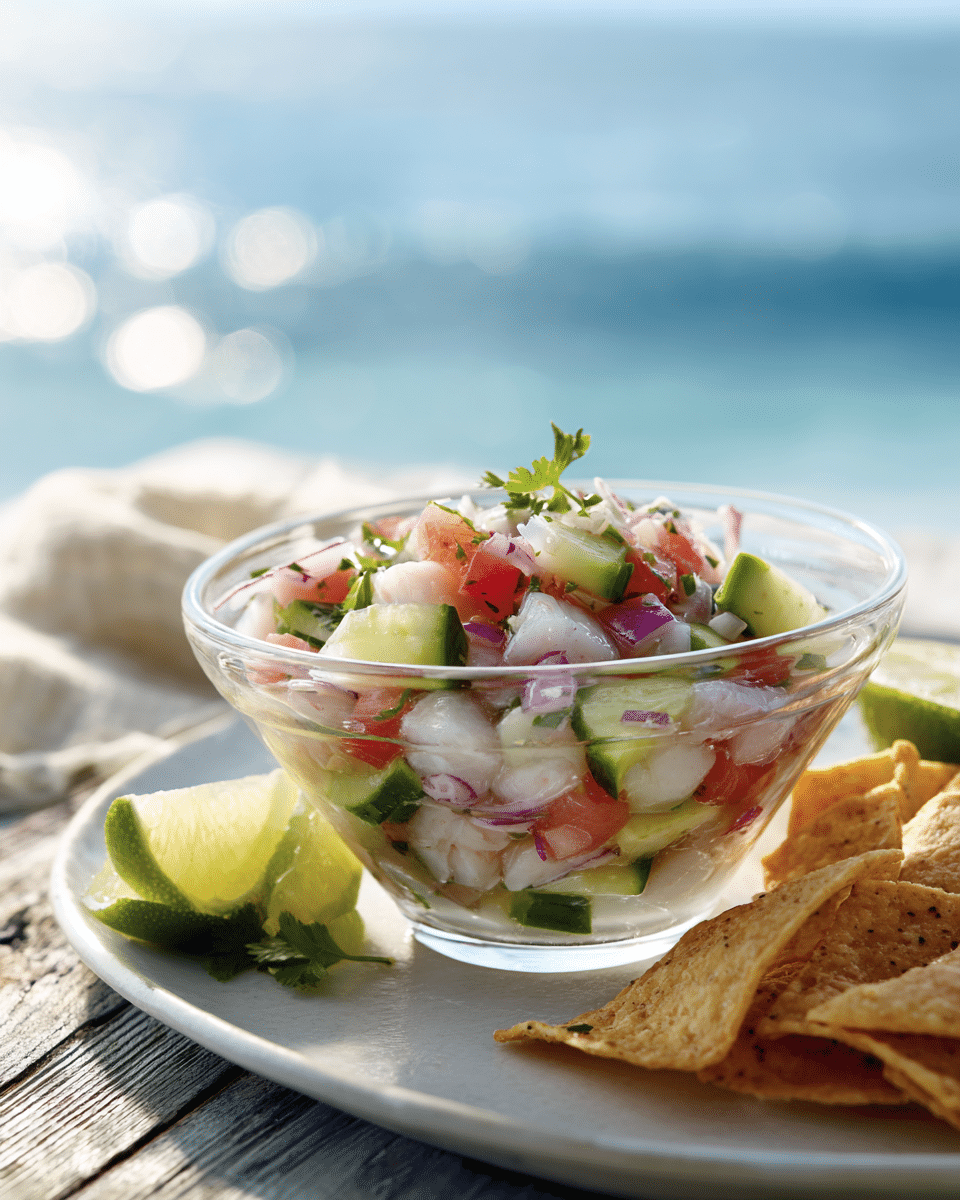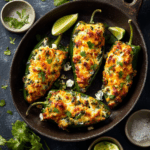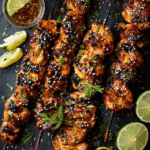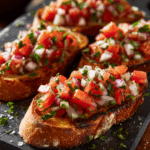Ceviche is a vibrant and refreshing dish popular along coastal regions, especially in Latin America. It features raw fish or seafood “cooked” in citrus juice, typically lime or lemon, which gives it a bright, zesty flavor. Often combined with fresh vegetables and herbs, ceviche is a light and healthy appetizer that highlights the freshness of its ingredients with a perfect balance of tangy, spicy, and savory notes.
FULL RECIPE
Ingredients
- 1 pound fresh firm white fish fillets (such as sea bass, snapper, or tilapia), cut into small cubes
- 1 cup freshly squeezed lime juice (about 8–10 limes)
- ½ cup finely chopped red onion
- 1 jalapeño, seeded and minced (adjust to taste)
- 1 medium tomato, diced
- ½ cup chopped fresh cilantro
- 1 cucumber, peeled and diced (optional)
- Salt, to taste
- Freshly ground black pepper, to taste
- 1 avocado, diced (optional)
- Tortilla chips or tostadas, for serving
Directions
- Place the cubed fish in a glass or ceramic bowl and pour the lime juice over it, ensuring the fish is fully submerged. Cover and refrigerate for 30–45 minutes, stirring occasionally, until the fish turns opaque and appears “cooked.”
- Drain most of the lime juice, leaving a little to keep the mixture moist.
- Add the chopped red onion, jalapeño, tomato, cilantro, and cucumber (if using). Mix gently to combine.
- Season with salt and freshly ground black pepper to taste.
- If using avocado, gently fold it in just before serving to maintain its texture and color.
- Serve chilled with tortilla chips or tostadas for scooping.
Nutrition Facts
- Calories: 140
- Protein: 22g
- Carbohydrates: 6g
- Fat: 4g
- Saturated Fat: 0.5g
- Cholesterol: 30mg
- Sodium: 250mg
- Fiber: 2g
- Sugar: 2g
Historical Background of Ceviche
Ceviche has deep roots in the coastal regions of Latin America, particularly Peru, Ecuador, and Mexico, where it is considered a traditional dish. Its origins trace back to indigenous peoples who marinated fish in fermented juices and later adopted the use of citrus brought by Spanish colonizers. Over time, ceviche evolved into the vibrant, citrus-based seafood dish enjoyed today, symbolizing the rich cultural heritage and connection to the sea in these regions.
Types of Seafood Used in Ceviche
While white fish such as sea bass, snapper, and tilapia are commonly used, ceviche can also be made with shrimp, scallops, octopus, or even mixed seafood. The choice of seafood depends on freshness, texture, and personal preference. The seafood must be very fresh and firm to withstand the citrus “cooking” process, which denatures proteins and gives the dish its signature texture without heat.
The Science Behind Citrus ‘Cooking’
Ceviche’s unique preparation relies on the acid in citrus juice, primarily lime or lemon, to chemically “cook” the fish. The acid breaks down proteins in the seafood, changing its texture and color much like heat would. This process preserves the freshness and flavor while creating a safe-to-eat dish, provided the seafood is fresh and handled properly.
Health Benefits of Ceviche
Ceviche is a nutrient-rich, low-calorie dish packed with lean protein and heart-healthy omega-3 fatty acids from fresh fish and seafood. It also provides vitamins and antioxidants from fresh vegetables and herbs like onions, tomatoes, and cilantro. The absence of heavy cooking oils and minimal processing makes ceviche a healthy option for those seeking a light yet flavorful meal.
Regional Variations and Flavor Profiles
Across Latin America, ceviche varies widely in preparation and ingredients. Peruvian ceviche is famous for its simple, sharp lime marinade and aji pepper, often served with corn and sweet potatoes. Mexican ceviche tends to include tomatoes, avocado, and sometimes a splash of tomato juice or clamato, adding a richer flavor. Ecuadorian versions often add ketchup and orange juice, creating a sweeter, tangier dish.
Pairing Ceviche with Sides and Beverages
Ceviche pairs beautifully with light and fresh accompaniments that complement its bright flavors. Common sides include tortilla chips, tostadas, or simple leafy salads. Beverages like cold beer, crisp white wines (such as Sauvignon Blanc), or non-alcoholic options like sparkling water with lime enhance the citrusy, refreshing profile of the dish and provide balance.
Tips for Selecting and Handling Seafood Safely
The key to excellent ceviche is the quality and freshness of the seafood. Purchase fish from trusted suppliers or markets with high turnover. Keep the seafood cold and consume ceviche shortly after preparation. Avoid seafood that smells fishy or has a slimy texture. When in doubt, use seafood specifically labeled “sushi-grade” or “sashimi-grade” for safety.
Customizing Heat and Acidity Levels
Ceviche’s flavor can be easily adjusted to suit different palates by varying the amount of jalapeño or other chili peppers and the quantity of lime juice. Some prefer a mild citrus flavor with little spice, while others enjoy a fiery kick. Balancing heat and acidity allows the freshness of the fish and vegetables to shine while providing a pleasant zing.
Storage and Leftover Advice
Because ceviche involves raw seafood “cooked” in acid, it is best consumed fresh within a few hours of preparation. Leftovers can be stored in the refrigerator but tend to lose texture and become mushy as the acid continues to break down the seafood. Avoid freezing ceviche, as this can ruin the delicate textures and flavors.
Serving Occasions and Cultural Significance
Ceviche is often enjoyed as a festive dish during warm weather and coastal celebrations, highlighting its association with freshness and community. It’s a popular choice for appetizers at gatherings or light meals on hot days. Its bright, vibrant colors and flavors make it a centerpiece for social dining, embodying the essence of sharing fresh, wholesome food.
Advertisement
Vegan and Vegetarian Alternatives
For those who prefer plant-based options, ceviche can be easily adapted to suit vegan and vegetarian diets without sacrificing flavor or texture. Popular substitutes include hearts of palm, king oyster mushrooms, or young coconut meat, which mimic the tender, slightly chewy texture of seafood.
Conclusion
Ceviche is a timeless dish that perfectly captures the essence of coastal cuisine through its bright, fresh, and zesty flavors. Its versatility in seafood choice, regional adaptations, and simple yet profound preparation make it a favorite across the world. By understanding the cultural significance, science, and health benefits behind ceviche, you can appreciate and enjoy this refreshing appetizer as both a culinary delight and a celebration of fresh ingredients.






